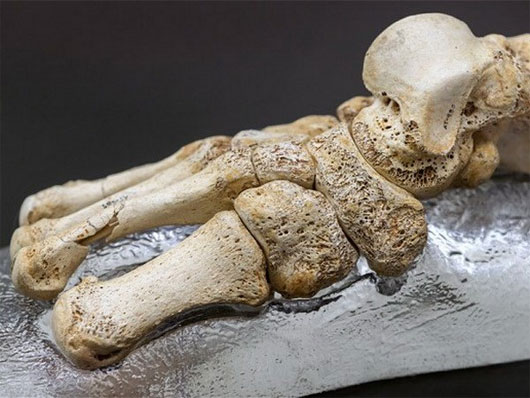The oldest DNA decoding of people 400,000 years ago
German anthropologists have deciphered the oldest DNA of a person from an ancient femur 400,000 years ago.
The upper thigh bone was discovered in a graveyard called Sima de los Huesos , north of the Sierra de Atapuerca plateau in Spain.
According to a study published in the British journal Nature on December 4, the expert team of Max Planck Evolutionary Anthropology Institute in Leipzicg City (Germany) took 2 grams of bone powder from the upper femur and prize. Code genome of mitochondrial DNA (mtDNA), mitochondrial DNA is transmitted from mother to child.

The feet of Homo heidelbergensis are in the Museum of Human Evolution in Burgos.(Source: AFP)
Later, scientists compared this genetic code to modern humans, gibbons, Neanderthals and Denisovans. The results showed that the Spanish strain was more closely related to the Denisovans than the Neanderthals, although geographically distant.
This result raises two assumptions that Spaniards share ancestors with Neanderthals and Denisovans, or the typical characteristics of the Spanish strain may have originated from a completely different strain of DNA. same as Denisovan.
According to Juan-Luis Arsuaga - Director of the Center for Research on the Evolution and Behavior of People in Madrid (Spain), the results of the study confirmed the complex model of ancestral evolution. Neanderthals and people today.
This discovery extends human knowledge of genetics 300,000 years ago, and also shows that human evolution can be more complex than previously known.
Recently, scientists have deciphered the genome of the two most extinct relatives of modern humans, Neanderthals and Denisovans. For modern people, the oldest genome was found in the mummy of the Otzi gang, a 5,300-year-old mummy was discovered in the Alps since 1991.
- 14 oldest ancient artifacts in the world
- Successfully code the DNA of the oldest mummy in the world
- 10 oldest antiquities in the world
- Found the oldest DNA of humanity
- The oldest man in the world died, aged 112 years
- Decoding the case of shocking network after 4,000 years
- Decoding the whole gene, will people be immortal?
- Helpless researchers look at the world's oldest mummy decomposing
- Mysterious ancient epitaph
- Not Everest, this is the oldest mountain on Earth
- Find the oldest stone ax in the world
- Discover the oldest universe spiral galaxy
 Discovered an ancient centipede fossil 99 million years old
Discovered an ancient centipede fossil 99 million years old Discovered bat-like dinosaurs in China
Discovered bat-like dinosaurs in China Discovered a 200-year-old bronze cannon of the coast
Discovered a 200-year-old bronze cannon of the coast Discover 305 million-year-old spider fossils
Discover 305 million-year-old spider fossils